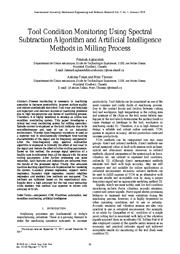A copy of this work was available on the public web and has been preserved in the Wayback Machine. The capture dates from 2018; you can also visit the original URL.
The file type is application/pdf.
Tool Condition Monitoring Using Spectral Subtraction Algorithm and Artificial Intelligence Methods in Milling Process
2017
International Journal of Mechanical Engineering and Robotics Research
Process monitoring is necessary in machining operation to increase productivity, improve surface quality and reduce unscheduled downtime. Tool wear and breakage are important and common sources of machining problems due to high temperatures and forces of machining process. Therefore, it is highly beneficial to develop an online tool condition monitoring system. This paper investigates a robust tool wear monitoring system for milling operation. Spindle current is employed as the fault indicator
doi:10.18178/ijmerr.7.1.30-34
fatcat:rbdalpvf6ba7lo5rwhg7vtxs2y

